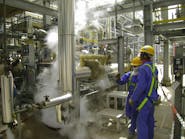Quiz Corner: Differential pressure level span (pressurized tank span)
Level instrumentation is required for a new vertical tank that is 2 meters in diameter, 5 meters high, and under pressure of up to 10 bar. The specific gravity of the liquid in the tank is 1.00. The bottom of the tank is supported 1 meter above a concrete slab. Which of the following are reasonable spans for a new differential pressure level transmitter?
- 2 meters of water column
- 3 meters of water column
- 4.5 meters of water column
- 5 meters of water column
- 10 meters of water column
The pressure in the tank vapor space will vary significantly, so the pressure at the lower tap near the bottom of the tank will not accurately infer level. Therefore, the differential pressure transmitter must sense both the bottom and vapor space pressures and subtract them to measure level. Determining a reasonable span involves establishing the elevation of the nozzle near the bottom of the tank.
Answer A and Answer E seem to reflect the tank diameter and pressure, respectively, but have no influence on the calibration. Relative to the lower tangent line (weld) of the tank, Answer D, Answer C and Answer B reflect tap locations of 0, 0.5 and 2 meters above the lower tangent line (weld) of the tank. Answer B would only measure a level in the upper 60% of the tank, which is probably not desirable. Locating the nozzle on the weld at the lower tangent is typically impractical or not recommended, so it would be reasonable to locate it a short distance above the tangent line, so both Answer C and Answer D are close to a reasonable span for this application.
Additional complicating factors
The problem statement states that this tank requires level instrumentation. Even though the level transmitter can generate a high-level alarm, regulations and good engineering practice often dictate the installation of an independent high-level switch to help prevent the tank from overflowing by sounding an alarm and sometimes taking action, such as closing a fill valve or turning off a pump. The high-level switch generally should not utilize the same measurement technology as the level transmitter.
David W. Spitzer
David W Spitzer’s new book Global Climate Change: A Clear Explanation and Pathway to Mitigation (Amazon.com) adds to his over 500 technical articles and 10 books on flow measurement, instrumentation, process control and variable speed drives. David offers consulting services and keynote speeches, writes/edits white papers, presents seminars, and provides expert witness services at Spitzer and Boyes LLC (spitzerandboyes.com or +1.845.623.1830).


